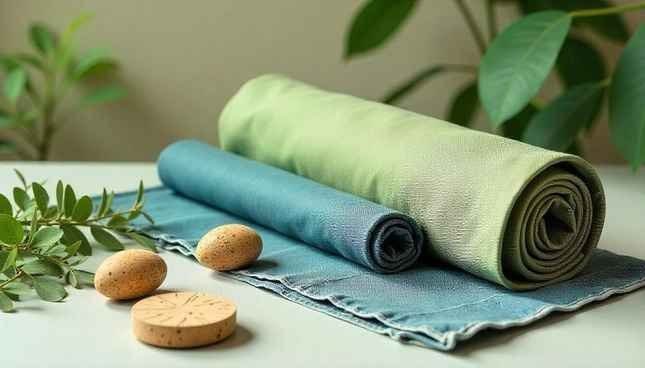Introduction to Sustainable Fashion
Sustainable fashion refers to a design philosophy and manufacturing process aimed at minimizing the negative environmental and social impacts associated with the fashion industry. This approach encompasses a wide range of practices, including the usage of sustainable fashion materials, ethical production methods, and a commitment to reducing waste throughout the lifecycle of clothing. The importance of sustainable fashion has never been more pronounced, given the pressing environmental challenges facing our planet, such as climate change, pollution, and resource depletion.

Traditional fashion practices often rely on fast fashion models, characterized by rapid production cycles and low-cost materials. These methods contribute significantly to pollution and waste, with millions of tons of textile waste generated each year. Moreover, they often involve unethical labor practices, where workers endure poor working conditions and insufficient wages. Such issues have prompted both consumers and industry stakeholders to reconsider their choices and advocate for more responsible alternatives.
In light of these concerns, the movement towards sustainable clothing materials has gained momentum. By incorporating materials that are organic, recycled, or produced with minimal environmental impact, brands can significantly reduce their carbon footprint. Examples of sustainable clothing materials include organic cotton, bamboo, Tencel, and recycled polyester. These materials not only promote ecological balance but also support ethical fashion practices that prioritize fair labor conditions.
As consumers become increasingly aware of the implications of their fashion choices, the importance of sustainable fashion continues to grow. This shift in consumer behavior is vital for encouraging brands to adopt sustainable practices and embrace transparency regarding their supply chain. By understanding these dynamics, we can better appreciate the role sustainable fashion materials play in revolutionizing the industry and paving the way for a more responsible future.
What Constitutes Sustainable Materials?
Sustainable materials are integral to the ethical fashion movement, embodying practices that minimize environmental impact while promoting social responsibility. To designate a material as sustainable, several criteria must be met, including the use of renewable resources, potential for recyclability, biodegradability, and minimal ecological harm during production processes.
Also Read Trending Post
- 20 High Protein Meal Prep Ideas for Weight Loss, Muscle Gain & Busy Lifestyles (2025 Guide)
- Healthy and Sustainable Rooftop Gardening Guide for Beginners: Simple and Effective Methods
- Eco-Friendly Meal Prep Ideas: 10 Essential Tips for Healthy and Sustainable Eating
- Microplastics: Invisible Danger in Our Food, Water, and Environment
- Top 25 Plant-Based Protein Sources Chart: Your Ultimate Visual Guide for a Healthier Diet!
Firstly, renewable resources play a crucial role in sustainable fashion materials. These materials are derived from sources that can replenish over time, such as organic cotton, hemp, and bamboo. Unlike conventional textiles that may deplete natural resources, these alternatives allow for sustainable clothing materials which can meet consumer demand without undermining ecological balances.
Recyclability is another important factor in evaluating sustainable clothing materials. Materials that can be reproduced after their initial use contribute significantly to waste reduction. For instance, recycled polyester, derived from post-consumer plastic bottles, demonstrates how waste can be transformed into valuable resources, creating a circular economy within the fashion industry.
Biodegradability further enhances the sustainability of clothing materials. Materials that naturally decompose, such as organic fibers and certain plant-based textiles, mitigate long-lasting environmental impact. This contrasts sharply with synthetic fibers that linger in landfills for decades, prompting a shift toward more ethical fashion materials, which prioritize the planet’s health.
Lastly, the production process significantly influences the sustainability of materials. Ethical sourcing and fair labor practices must be standard, ensuring that workers involved in the supply chain are treated fairly and equitably. Eco-friendly dyes and treatments can also help to reduce toxic outputs associated with fabric production. Sustainable fashion materials serve not only as a solution to environmental challenges but also embody a responsible approach to enhancing industry standards.
Popular Sustainable Fashion Materials
The fashion industry is making significant strides in adopting sustainable clothing materials, reflecting a growing consciousness about environmental impacts. Among the most popular sustainable fashion materials, organic cotton stands out due to its widespread accessibility and biodegradability. Unlike conventional cotton, organic cotton is grown without harmful pesticides and synthetic fertilizers, making it a safer option not only for the environment but also for those who wear the garments. Its soft texture and breathability add to its appeal, making it a preferred choice for various apparel items.
Another notable sustainable material gaining traction is hemp. Renowned for its durability and low environmental footprint, hemp requires significantly less water than cotton and utilizes natural pest resistance. This crop is versatile; its fibers can be used for textiles, while its seeds are a source of nutritious oil and food. The use of hemp in fashion not only promotes sustainability but also supports agricultural biodiversity.
Tencel, a brand name for lyocell, is also emerging as a frontrunner in sustainable clothing materials. Derived from sustainably sourced wood pulp, Tencel is produced in a closed-loop process, ensuring that solvents are reused, minimizing waste. This material is not only biodegradable but also comfortable and moisture-wicking, making it ideal for activewear and everyday clothing.
Additionally, recycled materials are redefining the fabric landscape. Materials such as recycled polyester, made from plastic bottles, are revolutionizing how we perceive waste in fashion. By repurposing discarded materials, brands significantly reduce resource consumption and landfill contributions. This shift towards ethical fashion materials demonstrates a commitment to reducing environmental impact while promoting innovative design approaches.
The Role of Innovation in Sustainable Materials
The fashion industry is undergoing a significant transformation, largely influenced by advancements in technology and innovation aimed at developing new sustainable materials. These innovations not only enhance the quality of sustainable clothing materials but also address the increasing demand for eco-friendly alternatives. One notable advancement is bio-fabrication, a process that utilizes living cells to produce materials. This technique allows for the creation of textiles that are both biodegradable and renewable, significantly reducing the environmental impact associated with conventional textile production.
Lab-grown materials represent another groundbreaking development in sustainable fashion. These materials, cultivated through advanced scientific techniques, provide an ethical alternative to traditional fabrics derived from animals. For example, lab-grown leather and silk offer cruelty-free options that maintain the luxurious feel and appearance of their counterparts while mitigating the ecological footprint. As consumers become more aware of the implications of their fashion choices, the demand for innovative sustainable clothing materials continues to rise.
Further, innovations in recycling processes are also reshaping the landscape of sustainable fashion materials. New technologies enable the efficient recycling of textiles, reclaiming fibers from discarded garments to create new fabrics. These advancements not only minimize waste but also conserve resources, making it possible to close the loop in fashion manufacturing. Brands that incorporate recycled materials into their collections demonstrate a commitment to ethical fashion materials and sustainability, appealing to increasingly conscious consumers.
Ultimately, the intersection of technology and sustainability presents a myriad of opportunities for the fashion industry. By embracing innovation, designers and brands can contribute to a more sustainable future, ensuring that the materials they use align with ethical fashion practices. The continual evolution of sustainable clothing materials and processes is essential for addressing the environmental challenges posed by the industry while meeting the needs of modern consumers.
Challenges Facing Sustainable Fashion Materials
The sustainable fashion materials movement has gained considerable traction in recent years, yet it continues to face a range of challenges that impede its widespread adoption within the industry. One of the primary obstacles is the elevated cost associated with the production of sustainable clothing materials. These ethical fashion materials often require advanced technologies and sustainable practices that can drive up prices, making them less accessible to consumers and small manufacturers. While some luxury brands successfully integrate these materials, many mass-market retailers struggle to implement them at a scale that remains economically viable.
Consumer awareness also plays a pivotal role in the acceptance of sustainable fashion materials. Although there has been an increasing interest in sustainability, many consumers remain unaware of the benefits of sustainable clothing materials or how to differentiate ethical options from conventional ones. This knowledge gap can lead to skepticism about the authenticity of brands that claim to prioritize sustainability, thereby inhibiting market growth. Educating consumers about the positive impacts of sustainable materials is essential for encouraging more informed purchasing decisions.
Moreover, supply chain concerns present another significant challenge for sustainable fashion materials. The complexity of sourcing ethical materials involves not just identifying reliable suppliers but also ensuring transparency and traceability throughout the supply chain. This process requires collaboration among various stakeholders and additional resources, which can be daunting for smaller brands. While some progress has been made with certification programs and sustainable sourcing initiatives, there is still a long way to go in fostering a more holistic adoption of these practices across the fashion industry.

Despite these hurdles, the movement towards sustainable fashion materials has made significant strides, paving the way for potential solutions. By addressing issues related to cost, consumer education, and supply chain management, the industry can work towards overcoming these challenges and fully embracing the sustainable ethos.
The Importance of Certification and Transparency
In the realm of sustainable fashion, the significance of certification systems cannot be overstated. Certifications such as the Global Organic Textile Standard (GOTS), OEKO-TEX, and Fair Trade serve as critical indicators for consumers, guiding them in identifying authentic sustainable clothing materials and brands. These certifications ensure that the textiles produced meet specific environmental and social standards, promoting eco-friendly practices throughout the supply chain. By choosing certified products, consumers can be confident that they are contributing to a more sustainable fashion landscape.
Certification systems play a fundamental role in assuring consumers that sustainable fashion materials are not merely marketed as ethical but are produced under rigorous guidelines that prioritize sustainability and fair labor practices. The presence of such certifications allows brands to communicate their commitment to sustainable practices transparently, fostering trust between consumers and producers. This transparency is essential, as it encourages mindful shopping choices that support ethical fashion materials and help to reinforce a marketplace favoring sustainability.
Moreover, it is important to acknowledge the vital role of transparency in supply chains. Without a clear understanding of how sustainable clothing materials are sourced, produced, and distributed, consumers may struggle to make informed decisions. Transparent practices empower buyers to scrutinize brands’ commitments to sustainability, thereby influencing their choices towards companies that genuinely prioritize eco-friendly methods. As more consumers advocate for sustainable practices, they play a significant role in driving shifts within the industry, encouraging brands to adopt more sustainable clothing materials and equitable business practices.
In conclusion, the importance of certification and transparency in the sustainable fashion movement cannot be underestimated. By supporting certified brands and advocating for transparent supply chains, consumers can contribute to a broader transition toward ethically produced clothing and a more sustainable fashion industry.
Consumer Responsibility and Sustainable Fashion
The modern fashion industry is undergoing significant changes, with an increasing emphasis on sustainability. Consumers play a pivotal role in this transformation by adopting responsible shopping habits and prioritizing sustainable fashion materials in their purchases. Conscious consumerism is not merely a trend; it is an essential approach that encourages individuals to consider the environmental and social impact of their clothing choices.
One of the main ways consumers can promote sustainable materials is by educating themselves about the various types of sustainable clothing materials available in the market. These include organic cotton, recycled polyester, hemp, and Tencel, among others. By understanding the benefits of these ethical fashion materials, consumers can make informed decisions that align with their values and support brands committed to sustainable practices.
The impact of purchasing decisions on the market cannot be overstated. When consumers actively choose brands that prioritize sustainable clothing materials, they send a clear message to the industry. This demand encourages manufacturers to invest in ethical practices, develop new sustainable fashion materials, and reduce their carbon footprint. Every purchase holds the potential to spur change, creating a ripple effect that promotes a larger shift towards sustainability in fashion.
For those seeking to support sustainable fashion, several practical tips can be helpful. First, opting for quality over quantity can lead to a more sustainable wardrobe. Investing in durable pieces made from sustainable materials not only reduces waste but also promotes longevity in fashion. Additionally, exploring second-hand options or clothing swaps can extend the lifecycle of garments, further minimizing environmental impact. Joining consumer movements that advocate for transparency in fashion supply chains can also empower buyers to hold brands accountable for their practices.
In conclusion, consumer responsibility is fundamental to the advancement of sustainable fashion materials. By making conscious choices and supporting ethical brands, individuals can contribute to a more sustainable future for the fashion industry.
Case Studies of Brands Leading in Sustainable Materials
As the demand for sustainable fashion materials increases, several brands have emerged as leaders in the movement towards ethical fashion. These brands not only prioritize sustainability but also demonstrate innovative practices that set a benchmark for others in the industry. One such brand is Stella McCartney, renowned for its commitment to animal welfare and sustainability. McCartney’s collections feature a range of sustainable clothing materials, including organic cotton, recycled polyester, and innovative vegan leather made from renewable resources. The brand’s approach extends beyond their materials; they adopt a circular fashion model, encouraging customers to recycle garments back into the supply chain.

Another noteworthy example is Patagonia, which has been at the forefront of promoting sustainable practices for decades. The brand utilizes various sustainable clothing materials, primarily organic cotton and recycled fibers, in their outdoor apparel. Patagonia also leads by example, implementing transparent supply chains and encouraging customers to consider the lifecycle of their products. Their “Worn Wear” program promotes responsible consumption by offering repair services and reselling used items, thereby minimizing textile waste.
Beyond these established brands, newer entrants to the sustainable fashion market are making substantial strides. For instance, Reformation has garnered a strong following by infusing style with sustainability. The brand sources eco-friendly fabrics like Tencel and repurposed materials to create fashionable and trendy clothing items. Their emphasis on ethical fashion materials and transparency in their production processes resonates well with environmentally conscious consumers.
These case studies illustrate the positive impact that using sustainable materials can have on the fashion industry. By adopting sustainable clothing materials, these brands are not only reducing their ecological footprint but are also inspiring others to consider the role of ethics and sustainability in fashion. As the industry evolves, the presence of champions like Stella McCartney, Patagonia, and Reformation will undoubtedly play a crucial role in steering more brands towards a sustainable future.
Future Trends in Sustainable Fashion Materials
The fashion industry is undergoing a significant transformation driven by the need for sustainability. As consumers become increasingly aware of their environmental impact, the demand for innovative and sustainable fashion materials is on the rise. This shift has prompted emerging trends that focus on not only creating eco-friendly alternatives but also on redefining consumer behavior towards more sustainable choices.
One notable trend is the advancement of biodegradable and compostable materials. Brands are recognizing the importance of reducing landfill waste, and new fibers derived from natural materials such as organic cotton, hemp, and Tencel are gaining traction. These sustainable clothing materials break down more easily than conventional fabrics, thus contributing positively to environmental health. Innovations in this area are likely to expand as designers seek to align with eco-conscious practices.
Another aspect of the future of sustainable fashion materials is the integration of recycled materials. The use of post-consumer waste in textile production has gained popularity as a means of reducing resource consumption and minimizing waste. For instance, brands are now using recycled polyester extracted from plastic bottles, demonstrating a commitment to circular fashion principles. This approach not only lowers the environmental burden but also encourages a shift toward ethical fashion materials that promote sustainability.
As technology advances, we can expect to see further developments such as lab-grown materials and vegan alternatives to traditionally sourced fabrics. Companies are investing in research to explore methods for producing high-quality textiles that do not rely on animal products or unsustainable agricultural practices. These innovations are indicative of a broader movement towards transparency and ethical sourcing, emphasizing the importance of sustainability in the future of fashion.
In conclusion, the evolution of sustainable fashion materials is a response to the pressing environmental challenges facing the industry. Emerging trends in biodegradable fabrics, recycled materials, and innovative technologies are shaping a future where sustainable clothing is not only viable but essential. By embracing these changes, the fashion industry can foster a more sustainable and ethical landscape for consumers and creators alike.
Conclusion: Building a Greener Future with Sustainable Fashion Materials
The journey toward a more sustainable future begins with the choices we make today—especially in the fashion industry, one of the most resource-intensive and polluting sectors in the world. By embracing sustainable fashion materials like organic cotton, bamboo, hemp, Tencel, and recycled fabrics, we shift toward a circular economy that values quality, longevity, and environmental responsibility over fast, disposable trends.
These materials are more than just fabrics; they represent a movement toward mindful consumption and ethical practices. Organic cotton reduces water waste and avoids harmful pesticides, while bamboo offers a renewable, biodegradable alternative to traditional textiles. Tencel, derived from wood pulp, provides a luxurious yet sustainable solution, and recycled materials give second life to resources that would otherwise end up in landfills.
By incorporating these materials into your wardrobe, you support brands that prioritize ethical labor, environmentally friendly processes, and innovative designs. Sustainable fashion proves that you don’t have to sacrifice style for sustainability—both can coexist harmoniously to create clothing that is kinder to people and the planet.
As consumers, our collective choices hold immense power to influence the industry. Each decision to purchase sustainably sends a message that we value our planet’s future over fleeting trends. Together, we can redefine the standards of fashion, turning it into a force for positive change. Let’s wear our values proudly and pave the way for a greener, more ethical future—one outfit at a time.
FAQ: Sustainable Fashion Materials
Where can I buy sustainable fashion materials or clothing?
Many ethical brands specialize in sustainable fashion. Look for companies certified by organizations like Fair Trade, GOTS (Global Organic Textile Standard), or OEKO-TEX. You can also find sustainable options in second-hand stores or online marketplaces.
What are sustainable fashion materials?
Sustainable fashion materials are textiles produced using environmentally friendly methods that minimize waste, conserve natural resources, and often have a lower carbon footprint. Examples include organic cotton, hemp, bamboo, Tencel, and recycled fabrics.
Why are sustainable materials better for the environment?
Sustainable materials reduce pollution, require fewer resources like water and energy, and often avoid harmful chemicals used in conventional fabric production. Many are biodegradable or recyclable, which helps reduce waste in landfills.
Are sustainable fashion materials durable?
Yes, many sustainable fabrics, such as hemp, organic cotton, and Tencel, are highly durable and long-lasting. They often outperform synthetic materials in terms of quality and lifespan when properly cared for.
Are sustainable materials more expensive?
While some sustainable materials may have a higher upfront cost, they often save money in the long run due to their durability and quality. Additionally, their production supports ethical labor practices and environmental preservation, making them a more conscious choice.
What is the difference between organic cotton and regular cotton?
Organic cotton is grown without synthetic pesticides or fertilizers, using natural farming methods that promote soil health and biodiversity. Regular cotton often relies on chemicals that harm the environment and require more water for cultivation.
Can recycled materials really make good clothes?
Absolutely! Recycled materials like polyester from plastic bottles or repurposed denim are transformed into high-quality fabrics that retain the strength and appearance of new textiles while reducing environmental impact.
Is bamboo fabric sustainable?
Bamboo is a renewable resource that grows quickly without the need for pesticides. However, the sustainability of bamboo fabric depends on its production process. Opt for brands that use eco-friendly manufacturing methods, such as mechanical processing.
Are there vegan options in sustainable fashion?
Yes! Vegan-friendly sustainable materials include organic cotton, Tencel, bamboo, hemp, and recycled polyester. These options avoid animal-derived products while still being eco-conscious.
How do I care for sustainable fabrics?
Always check the care label, but generally, sustainable fabrics require gentle washing in cold water and air drying to extend their lifespan. Using eco-friendly detergents also helps maintain their quality.












Pingback: Unlocking the Secrets of Viscose Fabric: Why It’s the Eco-Friendly Choice for Fashionistas!
Great web site. A lot of useful info here. I am sending it to several friends ans also sharing in delicious. And certainly, thanks for your sweat!
Your comment is awaiting moderation.